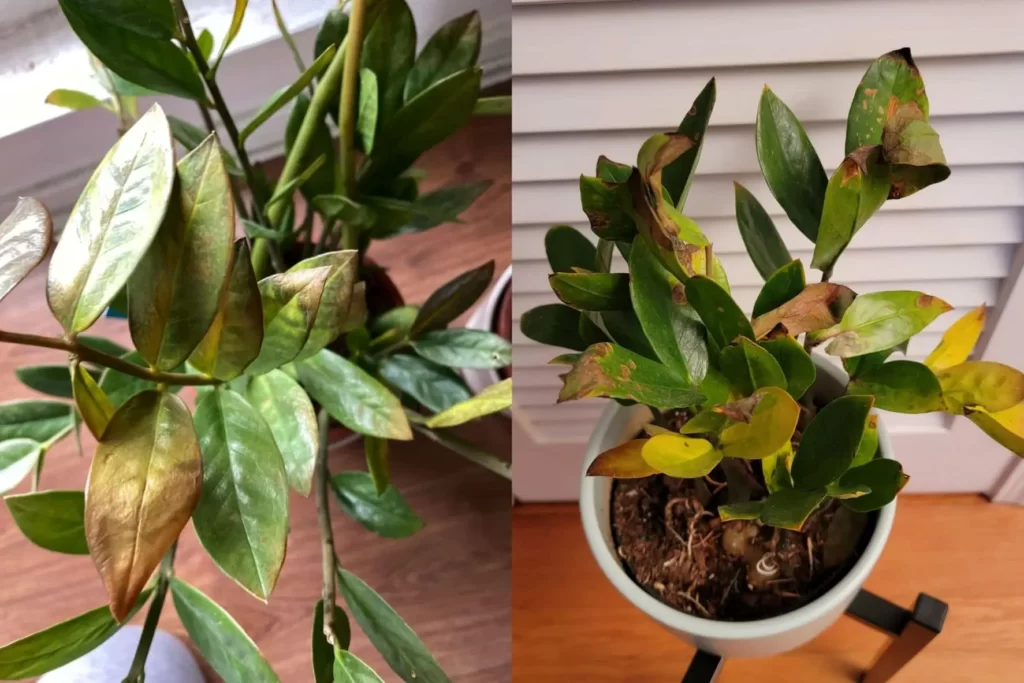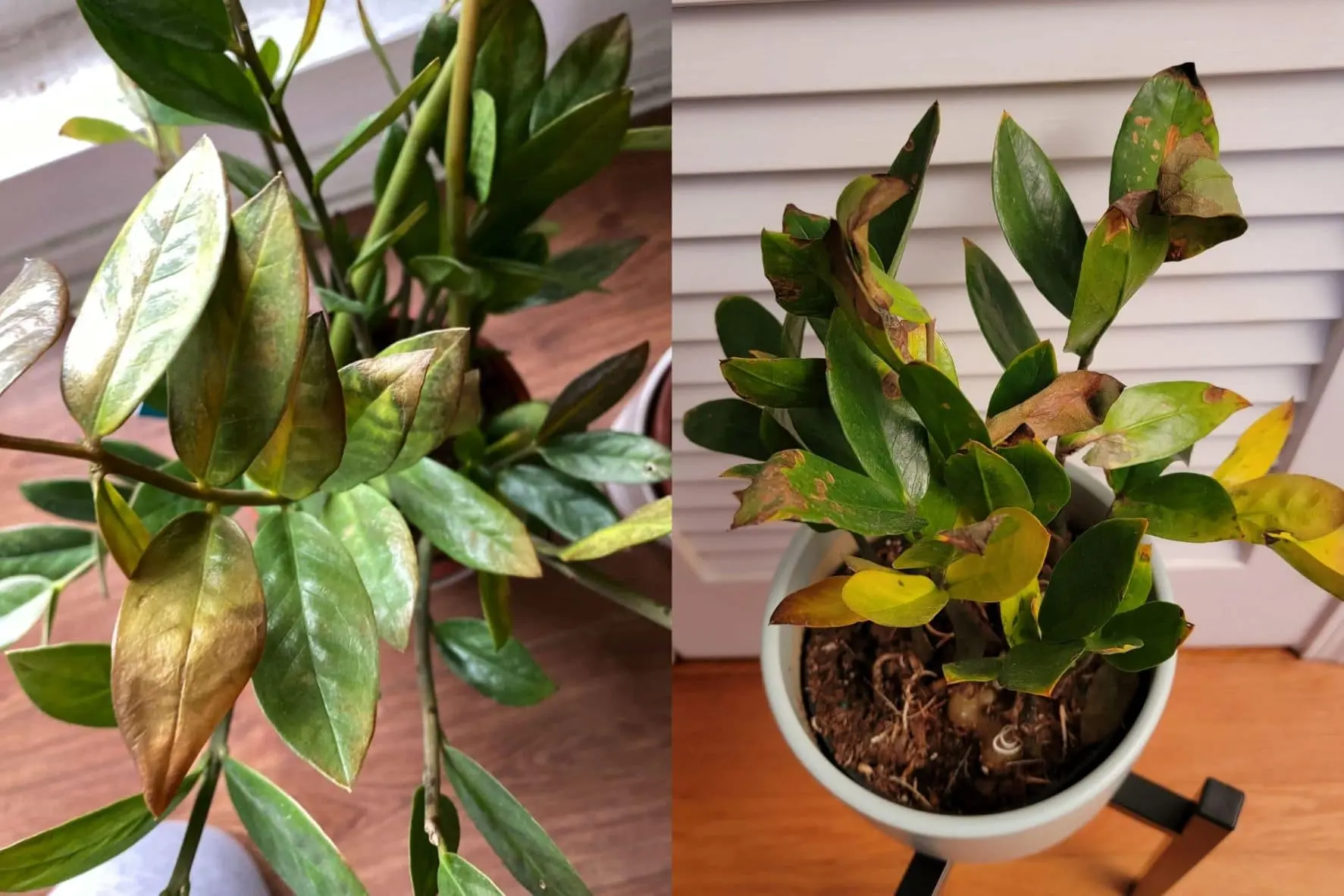The ZZ plant, also known as the Zanzibar Gem, is a popular houseplant due to its attractive dark green foliage and resilience to neglect.
While it’s relatively easy to take care of, there are still certain problems that can arise when growing this plant.
One of the most common issues is brown leaves, which can indicate something more serious than just an overwatering problem.
Here’s what you need to know about why your ZZ plant’s leaves or stems might be turning brown, and what you can do about it.

Why are ZZ Plant Leaves Turn Brown?
In many cases, brown leaves on a ZZ plant are caused by over-watering, underwatering, and over-light.
The leaves may become yellowish-brown and curl inward if the soil is too dry, or too wet, or they might become yellowish-brown with black patches if they’re receiving too much direct sunlight.
If the problem persists even after adjusting the amount of water or light, then there could be other factors at play such as pests, disease, or nutrient deficiencies.
Other causes of brown leaves include improper fertilization or salt buildup in the soil from over-watering.
If your fertilizer is too strong or not organic, it can cause excessive salts in the soil that will cause leaf tips to become discolored and die back.
Additionally, under-watering can also cause older leaves to turn yellow and brown due to root rot or lack of moisture in the soil.
You can also read details about the causes of why ZZ plant leaves fall off.
How To Treat Brown Leaves
The first thing you should do if you notice your ZZ plant’s leaves turning brown is adjust its environment to make sure it has adequate light and water levels for its needs.
Make sure it’s getting enough bright indirect light but not too much direct sun exposure, and check that its soil isn’t overly dry and overwet before watering it deeply but infrequently (every two weeks).
You may want to feed your plant some liquid fertilizer during its active growing season (spring and summer) for extra nutrition.
If this doesn’t help restore your plant back to health then you should inspect it carefully for signs of pests like mealybugs or spider mites which could be causing stress leading to discoloration in its leaves.
You’ll also want to check around your home for any drafts which could be contributing to stress on your plant as this often leads to leaf drop and discoloration as well.
Additionally, you should make sure there isn’t a nutrient deficiency by adding some compost into the potting mix or giving it an occasional dose of liquid fertilizer specially made for houseplants if needed.
If none of these things work then unfortunately you may have no choice but to remove affected leaves from your ZZ plant before they spread their damage further down onto other parts of the foliage – either by pruning them off yourself with sterilized scissors/snips or using a natural pesticide method such as neem oil solution sprayed onto affected areas directly once every few days until symptoms disappear completely (ideally less than 3 times per week).
Make sure not to spray near any other plants though!
Also read: Dark or Black Spots on ZZ Plant Stems: Causes and Solutions.
Additional Tips:
The best course of action for treating brown leaves on a ZZ plant is to try and correct any potential causes or issues that might be contributing to their discoloration.
This may involve adjusting its environment in terms of water, light, and fertilization levels, as well as checking for pests or nutrient deficiencies.
If these adjustments don’t help, you may need to remove affected leaves from your plant and take steps to prevent the problem from spreading further.
You should also consult a professional if you notice any other concerning symptoms on your ZZ plant, such as discoloration or spots that are not limited to its leaves.
With a little careful monitoring and care, you should be able to help your ZZ plant recover and thrive!
Conclusion:
So, why are ZZ plant leaves turning brown or discolored? There are a number of potential causes, including root rot, pest infestation, nutrient deficiencies, and environmental stress.
To help correct this issue, you should carefully monitor your plant’s environment and look for any signs of disease or pests.
Additionally, you may want to adjust its watering and fertilization schedules as well as take steps to prevent drafts and provide it with extra nutrients.
If you notice no improvement after making these changes, then you may need to remove any damaged or discolored leaves from the plant or even prune it back to help prevent the problem from spreading further.
With a little careful monitoring and care, your ZZ plant should be able to recover and thrive!
Now you know why your ZZ plant leaves are turning brown or yellow.
If you have any additional questions about this blog post, just leave them in the comments section below and we’ll get back to you as soon as we can!
Thanks for reading!
Related FAQs:
How often should I water my ZZ plant to prevent brown leaves?
ZZ plants prefer to dry out between waterings, so it’s best to water deeply but infrequently. Allow the top inch or two of soil to dry out before watering again, typically every two weeks or so.
Can too much sunlight cause ZZ plant leaves to turn brown?
Yes, ZZ plants prefer bright indirect light and can suffer from sunburn if exposed to too much direct sunlight. If you notice brown patches on leaves, consider moving the plant to a spot with more filtered light.
What should I do if I suspect pests are causing brown leaves on my ZZ plant?
Inspect the plant closely for signs of pests like mealybugs or spider mites. If you find any, treat the infestation with a natural pesticide like neem oil, being careful to follow instructions and avoid spraying other plants nearby.
How can I prevent brown leaves on my ZZ plant during the winter months?
During the winter, ZZ plants may need less frequent watering due to lower light levels and cooler temperatures. Be sure to adjust your watering schedule accordingly to prevent overwatering, which can lead to root rot and brown leaves.
Should I prune brown leaves off my ZZ plant, and if so, how?
Yes, it’s a good idea to prune off brown or damaged leaves to encourage healthy growth. Use sterilized scissors or pruning shears to carefully remove affected leaves at the base where they meet the stem.
What type of fertilizer should I use to prevent brown leaves on my ZZ plant?
Choose a balanced liquid fertilizer specifically formulated for houseplants and dilute it to half strength. Feed your ZZ plant during its active growing season (spring and summer) to provide it with the nutrients it needs to thrive.
Can drafts cause brown leaves on ZZ plants?
Yes, drafts from heaters, air conditioners, or open windows can stress ZZ plants and lead to brown leaves. Try to place your plant away from drafty areas to prevent this issue.
How can I tell if brown leaves on my ZZ plant are caused by nutrient deficiencies?
Look for other signs of nutrient deficiencies, such as yellowing or stunted growth. If you suspect a deficiency, you can try adding compost to the soil or feeding your plant with a balanced liquid fertilizer to provide it with the necessary nutrients.
Is repotting necessary if my ZZ plant’s leaves are turning brown?
Repotting may be necessary if your ZZ plant is suffering from root rot due to overwatering or if it has outgrown its current pot. However, if the brown leaves are not accompanied by other signs of stress and the plant is otherwise healthy, repotting may not be needed.
What should I do if my ZZ plant’s leaves are turning brown but the soil is still moist?
If the soil is moist but the leaves are turning brown, it could indicate a problem with root rot. Carefully remove the plant from its pot and inspect the roots for signs of rot. Trim away any damaged roots and repot the plant in fresh, well-draining soil.
Can low humidity cause brown leaves on ZZ plants?
ZZ plants are relatively tolerant of low humidity, but excessively dry air can still cause stress and lead to brown leaf tips. To increase humidity around your plant, you can mist it regularly, place a humidity tray nearby, or use a room humidifier.
Are there any common diseases that cause brown leaves on ZZ plants?
While ZZ plants are generally resistant to pests and diseases, they can still be affected by fungal infections such as leaf spot. If you suspect a disease is causing brown leaves on your ZZ plant, remove affected leaves and treat the plant with a fungicide according to the product instructions.
Should I fertilize my ZZ plant if its leaves are turning brown?
If your ZZ plant’s leaves are turning brown due to nutrient deficiencies, fertilizing can help. Choose a balanced fertilizer and apply it according to the manufacturer’s instructions during the plant’s active growing season.
Can over-fertilizing cause brown leaves on ZZ plants?
Yes, over-fertilizing can lead to salt buildup in the soil, which can cause brown leaf tips and edges. To prevent this, dilute fertilizer to half strength and only apply it during the plant’s active growing season.
What should I do if my ZZ plant’s leaves continue to turn brown despite my efforts to correct the problem?
If you’ve tried adjusting watering, light, and fertilization levels, as well as treating for pests and diseases, and your ZZ plant’s leaves continue to turn brown, it may be a sign of more serious underlying issues. Consider consulting with a professional plant care specialist for further advice and assistance.
Can temperature fluctuations cause ZZ plant leaves to turn brown?
ZZ plants prefer stable temperatures and can be sensitive to extreme fluctuations. Sudden changes in temperature, especially cold drafts or exposure to heat sources, can stress the plant and lead to browning of the leaves. Try to maintain a consistent temperature around your ZZ plant to prevent this issue.
Should I adjust my watering schedule if my ZZ plant’s leaves are turning brown?
Yes, adjusting your watering schedule can help address brown leaves on ZZ plants. If the leaves are browning due to overwatering, allow the soil to dry out more between waterings. If underwatering is the issue, water the plant more frequently to ensure the soil remains consistently moist (but not waterlogged).
Can poor soil drainage cause ZZ plant leaves to turn brown?
Yes, poor soil drainage can contribute to root rot, which can cause ZZ plant leaves to turn brown. Make sure your ZZ plant is potted in well-draining soil and that the pot has adequate drainage holes to prevent water from accumulating around the roots.
Is it normal for ZZ plant leaves to turn brown during winter months?
It’s not uncommon for ZZ plant leaves to turn brown or yellow during the winter months due to reduced light levels and lower temperatures. However, if the browning is severe or accompanied by other signs of stress, it may indicate an underlying issue that needs to be addressed.
Can using tap water with high mineral content cause ZZ plant leaves to turn brown?
Yes, tap water with high mineral content (e.g., hard water) can lead to salt buildup in the soil, which can cause ZZ plant leaves to turn brown. Consider using distilled or filtered water, or allow tap water to sit out overnight to allow chlorine and other chemicals to dissipate before watering your plant.
Should I prune brown leaves off my ZZ plant immediately, or wait to see if they recover?
It’s generally recommended to prune brown leaves off your ZZ plant as soon as you notice them. This helps prevent the spread of any potential issues and allows the plant to focus its energy on healthy growth. However, if the browning is minimal and you suspect it may be temporary, you can wait to see if the leaves recover before pruning.
Why is my ZZ plant losing its lower leaves?
One potential cause of this issue is root rot, which can be caused by over-watering or poor drainage in the soil. If your ZZ plant’s soil feels moist or wet, then you’ll need to let it dry out before watering again. You may also want to check around your home for drafts that could be causing stress on the plant, and inspect it carefully for signs of pests like mealybugs or spider mites to rule out any issues with disease or infestation.
What other steps can I take to treat discolored leaves on my ZZ plant?
In addition to adjusting the soil moisture and light levels, you may want to feed your plant a liquid fertilizer during its active growing season (spring and summer) for extra nutrition. Additionally, you can try pruning off any damaged or discolored leaves as well as applying a neem oil solution to the affected areas directly. As always, be sure to consult a professional before trying any new treatments to ensure that you are not causing more harm than good.

